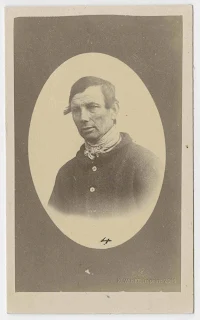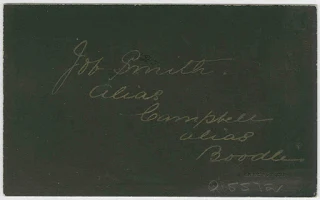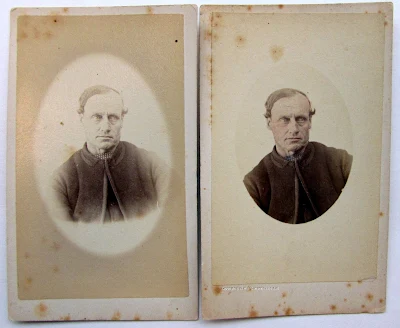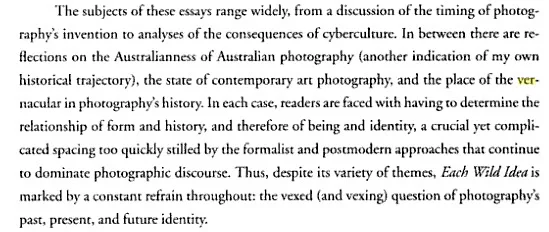.jpg)
TV snapshot of Geoff Batchen
Episode 1, The Genius of Photography: Fixing the Shadow (BBC 2007)
Broadcast on ABC HDTV February 2010.
Thomas J. Nevin began his photographic career in the mid 1860s within the urban free-settler society of a British penal colony - Hobart Tasmania. His apprenticeships were served with the highly commercial portrait photographers Alfred Bock, H. H. Baily and Charles A. Woolley. A lifelong partnership with the prolific Samuel Clifford, who advertised the sale of thousands of street views and landscape stereographs, ensured Nevin's livelihood as a stereographer during the late 1860s to the early 1870s. In 1872 his portraiture services were requested by the Nevin family solicitor and Attorney-General W.R. Giblin to provide the police and prison authorities with mugshots.
Thomas J. Nevin is somewhat remarkable in that his photographic records for the police, especially from the years 1872-1880s, are among the earliest to survive in Australian public collections and that his prisoner portraits are claimed as both art and vernacular photography. His portraiture techniques applied to judicial photography were "artistic" in a way that the mugshots produced by prison photographers in jurisdictions elsewhere such as Victoria & NSW, in Australia, and Millbank and Pentonville, in the UK were unequivocal, documentary captures. Nevin's prisoner photographs were not only posed, printed and framed as commercial portraits - either soft-focus framing or vignetted with darker backcloths - in some instances, they were also hand-coloured for heightened realism.
.

William Campbell, hanged as Job Smith 1875
NLA Collection nla.pic-vn4270353
Hand-tinted vignetted and mounted prisoner portrait by T.J. Nevin 1874
Photos taken at the National Library of Australia, 7th Feb 2015
Photos copyright © KLW NFC 2015 ARR. Watermarked.


Recto and verso in vignetted format within a dark mount of the hand-coloured carte-de-visite of prisoner Job Smith aka William Campbell .
Photographer: T. J. Nevin 1874. TMAG Collection Ref: Q15578.


Recto and verso of the same hand-coloured carte-de-visite in a buff mount of prisoner Job Smith alias Campbell alias Boodle.
Photographer: T. J. Nevin 1874. TMAG Collection Ref: Q15572

Walter Johnstone aka Henry Bramall aka Taylor
NLA Collection nla.pic-vn4270027
Vignette on left, not tinted but mounted, and hand-tinted mounted cdv
Original prisoner mugshots by T. J. Nevin 1874
Photos recto and verso taken at the National Library of Australia, 7th Feb 2015
Photos copyright © KLW NFC 2015 ARR. Watermarked.
Thomas Nevin displayed these images in his shop window at 140 Elizabeth St. Hobart to aid the public in recognizing a man wanted on warrant, as well as arranging a Rogues Gallery at the Town Hall Municipal Police Office where he was Hall and Office-keeper by 1876. "Photograph in this office" was announced accompanying warrants in the weekly Tasmanian police gazettes by 1874. A number of extant examples of T. J. Nevin's photographs of prisoners were stamped verso with the wording "T. J. Nevin, Photographic Artist" inside the government's Royal Arms insignia to signify joint copyright as government contractor with the Lands and Survey Department, the Police Department, and the Hobart City Corporation's Municipal Police Office at the Hobart Town Hall.
Prisoner photographs by T. J. Nevin 1875-78
David Scott Mitchell Collection, SLNSW Ref: PXB 274)
Scant attention has been accorded to Thomas J. Nevin's original place in Australian photography as one of the first photographers working with police. Petty arguments in the late 20th century have arisen around his photographer attribution by art-trained photohistorians and their essentialist neo-modernist notions of aesthetics, power and the artist. Apart from Ann-Marie Willis and her "concern for the ordinary" exemplified in her discussion of police inspector Paul Foeschle's Northern Territory images of Aborigines, few have wondered why there has never been a strong focus on our vernacular photographies. This is the challenge set forth by Geoff Batchen in his publication Each Wild Idea (MIT Press, 2002):
.jpg)
TV snapshot of Geoff Batchen
Episode 1, The Genius of Photography: Fixing the Shadow (BBC 2007)
Broadcast on ABC HDTV February 2010.

Extract: Preface by Geoff Batchen,
Each Wild Idea p. viii (MIT 2002).
Limited preview at Google Books.
In the first episode of the six-part series The Genius of Photography: Fixing the Shadow(BBC 2007), the "vernacular" is defined as any photography that is not "art": postcards, insurance records, passport photos, touristic photos, court documents, scientific images, forensic photographs taken at crime scenes etc etc.
The Genius Of Photography Deel 1 from Marcel Wiegerinck on Vimeo.
Below are more TV snapshots from Episode 1:

.jpg)
.jpg)
.jpg)
.jpg)
.jpg)
.jpg)
.jpg)
.jpg)
.jpg)
.jpg)
TV snapshots from Episode 1, The Genius of Photography: Fixing the Shadow (BBC 2007), broadcast on ABC HDTV February 2010.
